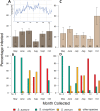Vector species-specific association between natural Wolbachia infections and avian malaria in black fly populations
- PMID: 29520067
- PMCID: PMC5843599
- DOI: 10.1038/s41598-018-22550-z
Vector species-specific association between natural Wolbachia infections and avian malaria in black fly populations
Abstract
Artificial infection of mosquitoes with the endosymbiont bacteria Wolbachia can interfere with malaria parasite development. Therefore, the release of Wolbachia-infected mosquitoes has been proposed as a malaria control strategy. However, Wolbachia effects on vector competence are only partly understood, as indicated by inconsistent effects on malaria infection reported under laboratory conditions. Studies of naturally-occurring Wolbachia infections in wild vector populations could be useful to identify the ecological and evolutionary conditions under which these endosymbionts can block malaria transmission. Here we demonstrate the occurrence of natural Wolbachia infections in three species of black fly (genus Simulium), which is a main vector of the avian malaria parasite Leucocytozoon. Prevalence of Leucocytozoon was high (25%), but the nature and magnitude of its association with Wolbachia differed between black fly species. Wolbachia infection was positively associated with avian malaria infection in S. cryophilum, negatively associated in S. aureum, and unrelated in S. vernum. These differences suggest that Wolbachia interacts with the parasite in a vector host species-specific manner. This provides a useful model system for further study of how Wolbachia influences vector competence. Such knowledge, including the possibility of undesirable positive association, is required to guide endosymbiont based control methods.
Conflict of interest statement
The authors declare no competing interests.
Figures



Similar articles
-
Dynamics of prevalence and diversity of avian malaria infections in wild Culex pipiens mosquitoes: the effects of Wolbachia, filarial nematodes and insecticide resistance.Parasit Vectors. 2014 Sep 16;7:437. doi: 10.1186/1756-3305-7-437. Parasit Vectors. 2014. PMID: 25228147 Free PMC article.
-
Contribution to the knowledge on black flies (Diptera: Simuliidae) as vectors of Leucocytozoon (Haemosporida) parasites in Lithuania.Parasitol Int. 2022 Apr;87:102515. doi: 10.1016/j.parint.2021.102515. Epub 2021 Nov 13. Parasitol Int. 2022. PMID: 34781013
-
Entomological study on transmission of avian malaria parasites in a zoological garden in Japan: bloodmeal identification and detection of avian malaria parasite DNA from blood-fed mosquitoes.J Med Entomol. 2011 May;48(3):600-7. doi: 10.1603/me10197. J Med Entomol. 2011. PMID: 21661321
-
Do avian malaria parasites reduce vector longevity?Curr Opin Insect Sci. 2018 Aug;28:113-117. doi: 10.1016/j.cois.2018.08.001. Epub 2018 Aug 25. Curr Opin Insect Sci. 2018. PMID: 30551761 Review.
-
Can Wolbachia be used to control malaria?Mem Inst Oswaldo Cruz. 2011 Aug;106 Suppl 1:212-7. doi: 10.1590/s0074-02762011000900026. Mem Inst Oswaldo Cruz. 2011. PMID: 21881776 Review.
Cited by
-
Integrating coalescent species delimitation with analysis of host specificity reveals extensive cryptic diversity despite minimal mitochondrial divergence in the malaria parasite genus Leucocytozoon.BMC Evol Biol. 2018 Aug 30;18(1):128. doi: 10.1186/s12862-018-1242-x. BMC Evol Biol. 2018. PMID: 30165810 Free PMC article.
-
A novel molecular and chromosomal lineage of the anthropophilic Simulium (Simulium) rufibasis subgroup (Diptera: Simuliidae) in Taiwan.Parasitol Res. 2018 Oct;117(10):3137-3143. doi: 10.1007/s00436-018-6011-7. Epub 2018 Jul 14. Parasitol Res. 2018. PMID: 30006809
-
Metaviromics Reveals Unknown Viral Diversity in the Biting Midge Culicoides impunctatus.Viruses. 2019 Sep 17;11(9):865. doi: 10.3390/v11090865. Viruses. 2019. PMID: 31533247 Free PMC article.
-
Differential gene expression in Drosophila melanogaster and D. nigrosparsa infected with the same Wolbachia strain.Sci Rep. 2021 May 31;11(1):11336. doi: 10.1038/s41598-021-90857-5. Sci Rep. 2021. PMID: 34059765 Free PMC article.
-
Evolutionary Ecology of Wolbachia Releases for Disease Control.Annu Rev Genet. 2019 Dec 3;53:93-116. doi: 10.1146/annurev-genet-112618-043609. Epub 2019 Sep 10. Annu Rev Genet. 2019. PMID: 31505135 Free PMC article. Review.
References
Publication types
MeSH terms
LinkOut - more resources
Full Text Sources
Other Literature Sources

